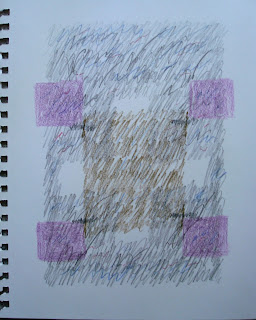During a retreat to an Episcopalian monastery about a year ago, I learned something important about how my spirituality has shifted over the years: I've never felt great about much of the Psalms, but this time around, I learned just how low my tolerance has become for incessantly chanting vindictive, paranoid Bronze Age poetry. So during my days there, I needed a practice of prayer that could also serve as an antidote to too much "Forgive Me" this, "I Am Not Worthy" that, and "Crush Everyone Who's Constantly Conspiring Against Me" whatever. These drawings were that alternative prayer.
Welcome to a space for the spirituality of gay and bisexual men. We have within ourselves the resources for our healing, liberation, and growth. Connecting with each other, we encounter the grace to lay hold of a richer, juicier life. Losing ourselves in deep play, we rediscover the bigger, freer, more joyous selves we're capable of becoming. Here I share my interest in personal and communal ritual, making art that expresses my inner life, and an intentional practice of erotic spirituality.

Saturday, April 16, 2016
In the Wake of Resurrection
I began making Jerusalem Cross drawings a couple of years ago, during mornings when I hold space at a drop-in art studio for guests of a daily lunch program at the Church of the Redeemer, Toronto. Whatever project I'm working on there, my attention is bound to be distracted--by requests for advice, by the constant task of putting materials back in order, and, once in a while, by the need to dial down the level of anxiety, manic energy, or conflict that comes into the room. These drawings gave me a pre-determined basic structure to work with and a freedom to play within. I could walk away from them and come back to them easily and quickly.
During a retreat to an Episcopalian monastery about a year ago, I learned something important about how my spirituality has shifted over the years: I've never felt great about much of the Psalms, but this time around, I learned just how low my tolerance has become for incessantly chanting vindictive, paranoid Bronze Age poetry. So during my days there, I needed a practice of prayer that could also serve as an antidote to too much "Forgive Me" this, "I Am Not Worthy" that, and "Crush Everyone Who's Constantly Conspiring Against Me" whatever. These drawings were that alternative prayer.
During a retreat to an Episcopalian monastery about a year ago, I learned something important about how my spirituality has shifted over the years: I've never felt great about much of the Psalms, but this time around, I learned just how low my tolerance has become for incessantly chanting vindictive, paranoid Bronze Age poetry. So during my days there, I needed a practice of prayer that could also serve as an antidote to too much "Forgive Me" this, "I Am Not Worthy" that, and "Crush Everyone Who's Constantly Conspiring Against Me" whatever. These drawings were that alternative prayer.
Subscribe to:
Post Comments (Atom)








Love these. I think the Jerusalem Cross offers endless sources for fruitful meditation and reflection. Solitary crosses embraced by a larger cross. Structured community within a framework of individuality. Pattern and Balance.
ReplyDeleteAs for the psalms. Deep stuff there. I have a long and fruitful history with them. And indeed am reminded of them often in my wandering about in the wilderness we call 21st century North American experience. They are not necessarily inspired as much as human. Not wisdom like the sayings of Confucius perhaps, but the frames of windows.
I'm really grateful to you for sharing a little of your experience of the Psalms--having read them in a sacred space I know you know well! Kathleen Norris has a chapter on them, and on the difficulties one can encounter with them, in The Cloister Walk.
ReplyDelete